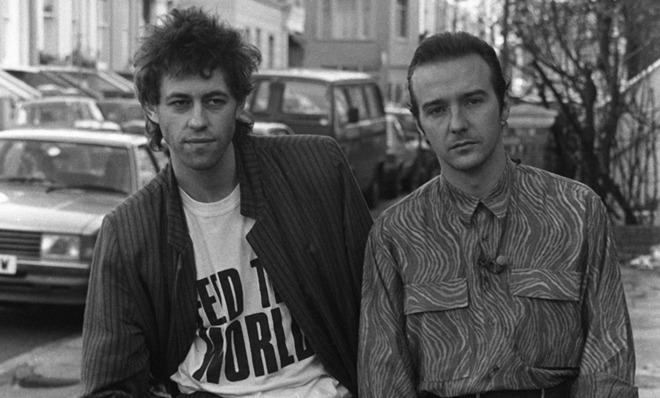The great paradox of the greatest rock 'n' roll showdown of all time
Remember "Do They Know It's Christmas?" vs. "We Are the World"?


The epic 1984-85 showdown between the best of American and British pop musicians was ostensibly about charity, but the two mega-groups that emerged to make music for famished Africans — Band Aid in Britain and USA for Africa in the States — was essentially a competition between the two powerhouses of rock 'n' roll.
And here's the great paradox: America had the better talent, from top to bottom. But Britain made the better song.
Moved by the brutal 1983-85 famine in Ethiopia — anyone who watched TV in this period will remember the young kids with grossly distended bellies and flies sitting, unmolested, on their faces — British producer Bob Geldof assembled the biggest rock and pop artists of the age: U2, Duran Duran, Sting, Boy George and Culture Club, Wham!'s George Michael, Paul Young, Phil Collins, and members of Spandau Ballet, Heaven 17, Boomtown Rats, Bananarama, and other, more obscure bands.
The Week
Escape your echo chamber. Get the facts behind the news, plus analysis from multiple perspectives.

Sign up for The Week's Free Newsletters
From our morning news briefing to a weekly Good News Newsletter, get the best of The Week delivered directly to your inbox.
From our morning news briefing to a weekly Good News Newsletter, get the best of The Week delivered directly to your inbox.
That's a really impressive list, reflecting the second great British Invasion of the 1980s. But then look at USA for Africa's roster: Produced by Quincy Jones and written by Michael Jackson and Lionel Ritchie, "We Are the World" featured Bob Dylan, Ray Charles, Willie Nelson, Stevie Wonder, Bruce Springsteen, Paul Simon, Billy Joel, Tina Turner, Kenny Rogers, Waylon Jennings, Smokey Robinson, Harry Belafonte, and Fleetwood Mac's Lindsey Buckingham, among many others.
Here's the fruit of their labor:
Here's Band Aid's "Do They Know It's Christmas?":
There are lots of ways to gauge success, and in music, tastes are clearly subjective. But "Do They Know It's Christmas?" is pretty obviously the better song. It has a catchier melody, and more haunting, from the Tears for Fears–sampled drums in the beginning onward. Plus, you can dance to it, and the hook with the chimes is catchier than anything in the Americans' song.
A free daily email with the biggest news stories of the day – and the best features from TheWeek.com
The lyrics are also slightly less schlocky. No, of course starving non-Christian Africans in the bush don't know it's Christmas; and there won't be snow because Christmas falls in Africa's summertime. But the greatest gift starving people would get might well be life, and idea of throwing your arms around the world at Christmastime is surely less grandiose than declaring that you are the world.
Bob Geldof wrote the words. That's fine: As lead singer for the Boomtown Rats he wrote catchy, lyrically interesting songs like "I Don't Like Mondays." But the music was written, produced, and largely recorded by Midge Ure, a musician probably unknown to anyone but fans of his former band Ultravox. He and Geldof had 24 hours of donated studio time to put the whole production together. And they did.
Ure regards "Do They Know It's Christmas?" as one of his worst songs, telling Scotland's Sunday Herald in 2007 that it doesn't have a chorus and "doesn't repeat itself once because it came together in such a bizarre way." It is clearly his most famous song, though, and he concedes that "the momentum the artists gave it in the recording studio is what made it." It is one of the best-selling singles of all time.
And by all rights, "Do They Know It's Christmas?" should be much worse that "We Are the World." The American effort was a collaboration between two musical legends at the top of their games: In January 1985, when the song was recorded, Michael Jackson was still riding high off of 1982's Thriller, one of the most successful and influential pop albums ever produced. Lionel Richie was in his post-Commodores heyday, with hits still spinning from his 1983 masterpiece Can't Slow Down. Their collaboration should have been great.
Instead, it turned out bland and over-produced. The pantheon of American artists did their part — everyone sounds good (Cyndi Lauper has sounded better) — but the song just isn't very good.
There are a million possible reasons. Maybe it was a case of too many cooks in the kitchen. Maybe Jackson and Richie played up each other's weaknesses rather then bringing out their strengths. Or perhaps the pressure of one-upping the Brits made them try too hard, leading toward a bit of grandiosity. Perhaps the combination of old and new stars didn't quite work — there was nobody from the Beatles or the Rolling Stones or even the Who or Kinks at the British session.
My guess is that it's a combination of many little things, led by the idea that the 1980s adult-contemporary stylings of "We Are the World" just haven't aged as well as the slightly gothic synth-pop of "Do They Know It's Christmas?"
Both songs went multi-platinum, spawned anniversary remakes, and helped feed starving children in Ethiopia. And both sessions helped transform popular music into a vehicle for social change. But they also pitted the set of Britain against America's pop-rock royalty.
America had all the advantages. Britain won. Go figure.
Peter has worked as a news and culture writer and editor at The Week since the site's launch in 2008. He covers politics, world affairs, religion and cultural currents. His journalism career began as a copy editor at a financial newswire and has included editorial positions at The New York Times Magazine, Facts on File, and Oregon State University.
-
 Pipe bombs: The end of a conspiracy theory?
Pipe bombs: The end of a conspiracy theory?Feature Despite Bongino and Bondi’s attempt at truth-telling, the MAGAverse is still convinced the Deep State is responsible
-
 The robot revolution
The robot revolutionFeature Advances in tech and AI are producing android machine workers. What will that mean for humans?
-
 Health: Will Kennedy dismantle U.S. immunization policy?
Health: Will Kennedy dismantle U.S. immunization policy?Feature ‘America’s vaccine playbook is being rewritten by people who don’t believe in them’
